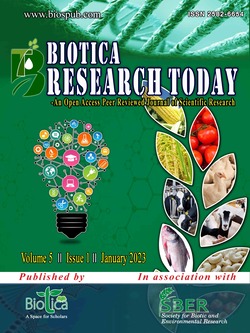
Challenges of IPM Adoption in India
Sanhita Chowdhury*
Dept. of Entomology, Post Graduate College of Agriculture, Dr. Rajendra Prasad Central Agricultural University, Pusa, Samastipur, Bihar (848 125), India
Sanjay Kumar Sahoo
Dept. of Entomology, Post Graduate College of Agriculture, Dr. Rajendra Prasad Central Agricultural University, Pusa, Samastipur, Bihar (848 125), India
B. Sujatha
Dept. of Entomology, Post Graduate College of Agriculture, Dr. Rajendra Prasad Central Agricultural University, Pusa, Samastipur, Bihar (848 125), India
Vinod Kumar Dubey
Dept. of Entomology, Post Graduate College of Agriculture, Dr. Rajendra Prasad Central Agricultural University, Pusa, Samastipur, Bihar (848 125), India
DOI: NIL
Keywords: Farmers, Insect-pest, Management strategy, Pesticide
Abstract
It is increasingly understood that rising agricultural pesticide use has negative effects on both human and environmental health. A substitute for the traditional pest management method is Integrated Pest Management (IPM). IPM can increase agricultural profitability by lowering the cost of pest control, and it also ensures fair, secure, sufficient, and consistent flows of both food and ecosystem services. In India, IPM has mostly remained an intellectual activity and hasn't had much of an impact on the farming community in terms of application or adoption. Lack of knowledge among farmers is a major concern as it contributes to their reluctance to employ IPM technology. The worldwide accepted strategy for pest management is Integrated Pest Management (IPM). Actually, it's often referred to as "integrated pesticide management." Here, we highlighted about the difficulties in true advancement and interpretation of the IPM method to achieve during its deployment and expansion.
Downloads
not found
Reference
Barfield, C.S., Swisher, M.E., 1994. Integrated pest management: ready for export? Historical context and internationalization of IPM. Food Review International 10, 215-267.
Brunner, J.F., 1994. Integrated pest management in tree fruit crops. Food Review International 10, 135-157.
Levins, R., 2007. From simple IPM to the management of agroecosystems. In: Perspectives in Ecological Theory and Integrated Pest Management. (Eds.) M. Kogan and P. Jepson. Cambridge: Cambridge University Press. pp. 45-64.
Perkins, J.H., 1982. Insects, experts, and the insecticide crisis: The quest for new pest management strategies. Plenum Press,New York. p. 304.
